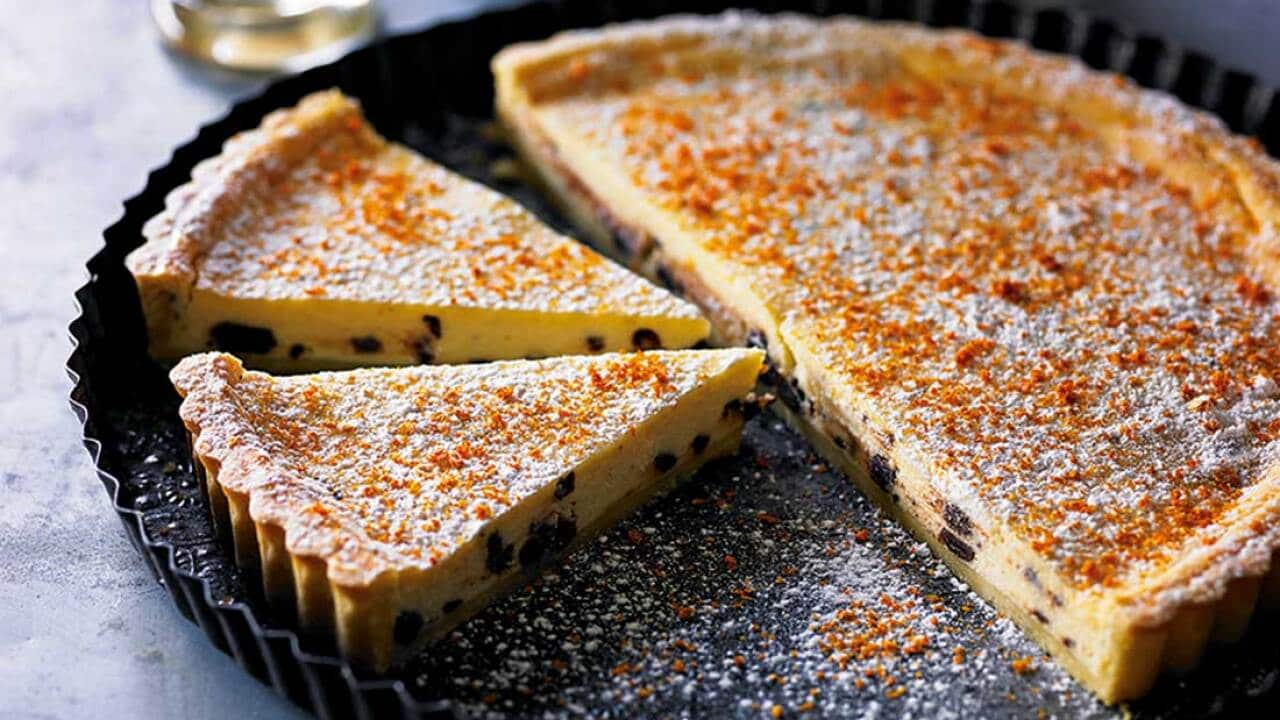serves
8-10
prep
30 minutes
cook
50 minutes
difficulty
Mid
serves
8-10
people
preparation
30
minutes
cooking
50
minutes
difficulty
Mid
level
Ingredients
- 300 g
- 600 g fresh ricotta cheese, drained (see Note)
- 150 g mascarpone
- 150 g caster sugar
- 75 g honey
- 2 eggs
- 3 egg yolks
- 150 g dark chocolate (65% cocoa solids)
- Finely grated zest of 2 oranges
- 30 ml pastis liqueur
- Pure icing sugar, for dusting
- Dried citrus zest, to serve, optional
Chilling time 1 hour
Instructions
You will need a 25 cm tart ring or tart tin with a removable base. Roll out the pastry on a lightly floured work surface until 5 mm thick, dusting with a little extra flour if necessary to stop the dough from sticking. Line the base and side of the tin with the pastry, then refrigerate for 30 minutes.
Preheat the oven to 175ºC. This tart can be cooked directly in the raw pastry shell but, just to be safe, you can begin the baking process by par-baking the crust. Line the pastry shell with foil, making sure the side of the shell is covered, then fill to the top with uncooked rice or baking beads. Bake for 15 minutes, or until the side of the pastry is golden. Unlike a full blind bake, which is usually reserved for very soft fillings, you want to stop baking as soon as the pastry around the side turns a light golden brown; the bottom should still be blonde. Remove the rice and foil and set aside to cool.
Using an electric mixer fitted with a paddle attachment, beat the ricotta, mascarpone, sugar and honey until well combined. With the motor on low speed, add the eggs and egg yolks one at a time, then increase the speed to medium and beat for another 2–3 minutes, or until well combined.
Using a large knife, finely chop the chocolate (don’t use a food processor to do this or the chocolate will melt). Combine the chocolate with the orange zest and pastis, then add to the cheese mixture and beat for 30 seconds.
Reduce the oven temperature to 130ºC. Pour the filling into the tart shell, then bake on the bottom shelf of the oven for 35 minutes, or until the filling stops wobbling when the tart is gently shaken. Personally I find the brown skin usually found on cheesecakes and tarts a little unpalatable, so I always aim for a very blonde top. If you find that the top of the tart is browning too quickly, cover loosely with a piece of foil. This deflects the heat and slows down the colouration.
Just before serving, dust with a little icing sugar and, if you like, sprinkle with dried citrus zest. This tart is delicious served either warm or cold with a peppermint tea or strong coffee in the morning. Personally, I prefer it warm, with a generous scoop of mascarpone and a drizzle of honey… but that’s just me.
Note
• When baking simple, wholesome food, always choose the best ingredients. For this tart, I recommend using a soft Italian ricotta made of sheep’s milk, preferably made fresh from the delicatessen, drained overnight in a cloth. Alternatively, use any fresh ricotta, but it needs to be drained in either a piece of muslin (cheesecloth) or on paper towel to remove excess liquid.
Cook's Notes
Oven temperatures are for conventional; if using fan-forced (convection), reduce the temperature by 20˚C. | We use Australian tablespoons and cups: 1 teaspoon equals 5 ml; 1 tablespoon equals 20 ml; 1 cup equals 250 ml. | All herbs are fresh (unless specified) and cups are lightly packed. | All vegetables are medium size and peeled, unless specified. | All eggs are 55-60 g, unless specified.









